Review by Mark Bourne
"Purity of essence."
— General Jack D. Ripper
Mad Major Mark's ICBM countdown of reasons why you should stop worrying and love this 40th Anniversary Two-Disc Special Edition:
Imagine something that could end the world today. It must be widely known to exist now, making the threat not only possible and plausible, but gravely, unquestionably real to a significant portion of the public, the government, and the military. Biological warfare. A virulent super-virus. A "doomsday" meteor. Whatever. Now imagine someone making a movie about it. Horrifying in its depictions. In which humanity fails to prevent its own extinction. Oh yeah — it's a comedy.
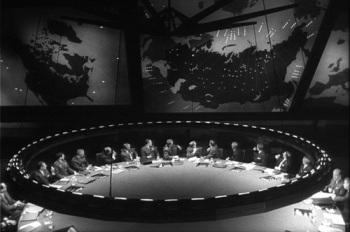 To audiences old enough in 1964 to be cognizant of the world around them, whose awareness of a Russian nuclear arsenal pointed at the U.S., of U.S. nuclear missiles pointed at Russia from silos across the midwest, of "duck and cover" drills in public schools, of homemade bomb shelters and maps of radiation fallout zones — whose day-to-day fatalism regarding an oncoming apocalypse was as ordinary as today's frets about stock market trends — Dr. Strangelove was a shocking pie in the face. Its comedic skew on deadly serious topics and caricatures of military planners and blinkered politicos seemed more incisive than its humorless contemporaries such as Fail-Safe and On the Beach. When it premiered, JFK was only two months dead, and the fear of imminent destruction surrounding the Cuban Missile Crisis was still a recent memory. Add anxiety about out-of-control technologies, of people serving machines rather the other way around, and the time was exactly right for an antiestablishment film that picked the scab off our national neuroses. This most mordant of black comedies made us laugh grimly though clenched teeth.
To audiences old enough in 1964 to be cognizant of the world around them, whose awareness of a Russian nuclear arsenal pointed at the U.S., of U.S. nuclear missiles pointed at Russia from silos across the midwest, of "duck and cover" drills in public schools, of homemade bomb shelters and maps of radiation fallout zones — whose day-to-day fatalism regarding an oncoming apocalypse was as ordinary as today's frets about stock market trends — Dr. Strangelove was a shocking pie in the face. Its comedic skew on deadly serious topics and caricatures of military planners and blinkered politicos seemed more incisive than its humorless contemporaries such as Fail-Safe and On the Beach. When it premiered, JFK was only two months dead, and the fear of imminent destruction surrounding the Cuban Missile Crisis was still a recent memory. Add anxiety about out-of-control technologies, of people serving machines rather the other way around, and the time was exactly right for an antiestablishment film that picked the scab off our national neuroses. This most mordant of black comedies made us laugh grimly though clenched teeth.
Twenty years later, my generation, too young to "get" Dr. Strangelove in the '60s, were given our own anxieties about the "evil empire" thanks to escalating Cold War tensions and a duck-and-cover "Strategic Defense Initiative" during the Reagan era. So here's a movie that once again hit close to home. Its bubbly bleakness remained funny in large part because the horrific events (and people) it depicted still seemed so unnervingly plausible.
Today we're in our distinctly unKubrickian 21st century. If to you the 1960s is a decade glimpsed only through the paisley lens of the Austin Powers movies, and if you're too young to remember the '80s beyond images of a pre-weirdout Michael Jackson, consider yourself lucky that you never had playground conversations about what would happen to your town when the bombs dropped. And still you get this fold-over-laughing funny, kinky, superbly crafted satire that's neocon fresh to this day.
|
9.
The production trivia
(as reported in the documentary, Inside the Making of Dr. Strangelove, found on this release's Special Features disc)
|
Dr. Strangelove was based on the serious, realistic 1958 nuclear war novel Red Alert, which was originally published in Britain as Two Hours To Doom. The novel's author was Peter George, an ex-RAF flight lieutenant and nuclear-disarmament activist. He wrote it under a pseudonym, Peter Bryant.
Dr. Strangelove himself does not appear in the novel. He was added by Kubrick and co-screenwriter Terry Southern. Southern was a novelist best known for the titillating book Candy. He wound up collaborating with Kubrick on the screenplay after Esquire magazine assigned Southern to write an article about the film.
Kubrick began the project with the intent of making a serious thriller about nuclear war, but as he worked deeper into the script he realized that viewing the horrifying story through a satirical comic lens would better magnify the ideas he wanted to communicate. "The film keeps the same suspense frame," Kubrick said. "But the more I worked on it the more I was intrigued by the comic aspects ... comedy can be more realistic than drama because it takes into account the bizarre."
Early drafts of the script began as a report from extraterrestrials studying Earth long after humanity's extinction.
Yep, that's James Earl ("Luke, I am your father") Jones making his first screen appearance. Kubrick hired Jones after seeing him in a production of The Merchant of Venice that starred George C. Scott. Though never named in the dialogue, his character is Lieutenant Lothar Zogg. Ten years later he was headlining as King Lear in Central Park.
The girl in Major Kong's Playboy magazine centerfold is General "Buck" Turgidson's secretary, Miss Scott. She was played by Tracy Reed, the stepdaughter of British director Sir Carol Reed (The Third Man). That same year she appeared again with Peter Sellers in A Shot in the Dark.
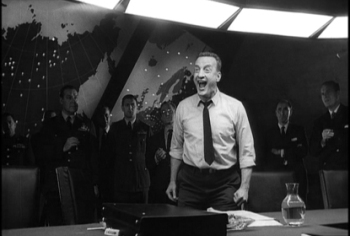 Beyond the characters Mandrake, President Merkin Muffley, and Dr. Strangelove, Sellers was also originally slated to play Major Kong. But mastering a Texas accent proved difficult, and while shooting the famous bomb scene 15 feet above the stage floor, Sellers fell and broke his leg. Knowing that no ordinary actor could replace Sellers, Kubrick cast Slim Pickens, whom he had worked with briefly in a previous movie, because Pickens was by nature already a cowboy-hat-wearing, prairie-swaggering, good-ol'-boy personality.
Beyond the characters Mandrake, President Merkin Muffley, and Dr. Strangelove, Sellers was also originally slated to play Major Kong. But mastering a Texas accent proved difficult, and while shooting the famous bomb scene 15 feet above the stage floor, Sellers fell and broke his leg. Knowing that no ordinary actor could replace Sellers, Kubrick cast Slim Pickens, whom he had worked with briefly in a previous movie, because Pickens was by nature already a cowboy-hat-wearing, prairie-swaggering, good-ol'-boy personality.
Sex. From the opening shots of a midair refueling to its characters' collegiate Brit-comedy names (Turgidson, Merkin Muffley) to Slim Pickens straddling a bomb to atomic orgasm, this may still be the Hollywood feature most dripping with subtle (and otherwise) post-Freudian innuendo. Equating masculine sexuality with warfare and "missile envy" may be old hat today, but it's still never been done better.
While shooting aerial footage of wastelands over Greenland, the second unit camera crew accidentally stumbled across a secret U.S. military base, which forced down their plane under suspicion of being Russian spies.
Kubrick's original ending was a pie fight between the Russians and the Americans in the War Room. It was filmed but deemed unusable. The Kubrick estate has not granted permission for the entire film sequence's release in any form.
The world premiere was scheduled for December 12, 1963. John F. Kennedy's assassination in Dallas occurred on November 22, making it inappropriate to release such a film so soon afterward. The release was pushed out to late January '64. Watch Major Kong's lips during his quip that "a fella could have a pretty good weekend in Vegas with all that stuff," referring to the survival kit. The word "Vegas" was overdubbed to replace the original "Dallas."
Reportedly, when Ronald Reagan became president he asked to see the War Room in the White House. When his Chief of Staff said that the War Room did not exist, Reagan assured him that he'd seen it in that movie, Dr. Strangelove.
And here are two freebies from Mad Major Mark: (1) The radio in Kong's bomber is called the "CRM114." In Kubrick's 2001: A Space Odyssey, the serial number on one of the pods is "CRM114," and in his A Clockwork Orange the central character Alex is injected with "serum 114." (2) Major Kong's Russian target is the missile base at "Laputa," more than 200 years after Jonathan Swift — another acid satirist — named Laputa in Gulliver's Travels as a land populated by parodies of scientists. ("Laputa" can also be read as Spanish for "whore.")
A real cowboy who ended up in Hollywood playing cowboys (Blazing Saddles), Pickens will forever be remembered for his role as bomber pilot Major "King" Kong. One of the most iconic images in filmdom is that of Pickens waving his Stetson like a bronco buster as he rides a nuclear bomb to target zero.
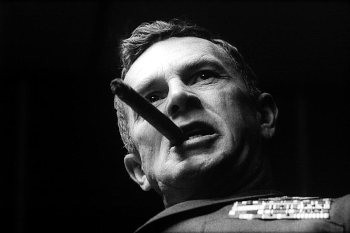 Who would have thought that an actor who
Who would have thought that an actor who
- loved the sea but despised acting and movie-making,
- abandoned Hollywood to become a commando and gun-runner in Yugoslavia,
- joined the Communist party,
- quit the party because "I'd rather be wrong on my own than be right on somebody else's say-so,"
- during the McCarthy-era Red Scare confessed his Communist ties before Congress ("I don't think you have the foggiest notion of the contempt I have had for myself since the day I did that thing"),
- said of his films, "Bastards, most of them, conceived in contempt of life and spewn out onto screens across the world with noxious ballyhoo; saying nothing, contemptuous of the truth, sullen, and lecherous,"
would have come out of retirement to be so damn perfect as mad General Jack D. Ripper, whose "purity of essence" leads to global Armageddon? To this day, "precious bodily fluids" hangs high in Hollywood's catchphrase hall of fame alongside "Rosebud" and "You talkin' to me?" and "Use the Force, Luke."
The world lost a first-rate comic actor when George C. Scott returned to serious dramatic roles rather than continue the wildly funny turn he gives us here as hawkish general "Buck" Turgidson. Scott gives even Peter Sellers strong competition in the laugh-out-loud sweepstakes. Roger Ebert, in an essay provided with this 40th Anniversary DVD, notes how much energetic comic mileage Scott got from Turgidson's face by approaching the role as "a duet for voice and facial expression."
This against-type performance became Scott's favorite, and he said that he had so much fun he felt guilty getting paid for it. He later won (and refused to accept) an Oscar for inhabiting the title role in Patton. He earned that Oscar, alright, though when the time comes to eulogize Scott, his General Turgidson will be remembered as an equal but opposite career peak with his General Patton.
|
5.
Peter Sellers, Peter Sellers, and Peter Sellers
|
 Any one of his performances here — Group Captain Mandrake, President Muffley, and Dr. Strangelove himself — would have distinguished Sellers mightily. Put them together and you have a screen record of one of the rare instances when the phrase "utter brilliance" isn't overreaching hyperbole. Yes, Rex Harrison was good in My Fair Lady, but here's the real Best Performance By An Actor for 1964. Intuitively gifted at characterization and improvisation, Sellers could riff on dialogue the way a great jazz musician creates amazing music. He regularly cracked up the Dr. Strangelove cast during shooting. We are a poorer species without him.
Any one of his performances here — Group Captain Mandrake, President Muffley, and Dr. Strangelove himself — would have distinguished Sellers mightily. Put them together and you have a screen record of one of the rare instances when the phrase "utter brilliance" isn't overreaching hyperbole. Yes, Rex Harrison was good in My Fair Lady, but here's the real Best Performance By An Actor for 1964. Intuitively gifted at characterization and improvisation, Sellers could riff on dialogue the way a great jazz musician creates amazing music. He regularly cracked up the Dr. Strangelove cast during shooting. We are a poorer species without him.
|
4.
It's one of the most quotable movies ever
|
"Well, I've been to one World Fair, a picnic, and a rodeo, and that's the stupidest thing I ever heard come over a set of earphones."
"I can no longer sit back and allow Communist infiltration, Communist indoctrination, Communist subversion, and the international Communist conspiracy to sap and impurify all of our precious bodily fluids."
"Mr. President, I'm not saying we wouldn't get our hair mussed. But I do say no more than ten to twenty million killed, tops. Uh, depending on the breaks."
"He'll see the big board!"
"Survival kit contents check. In them you'll find: one forty-five caliber automatic; two boxes of ammunition; four days' concentrated emergency rations; one drug issue containing antibiotics, morphine, vitamin pills, pep pills, sleeping pills, tranquilizer pills; one miniature combination Russian phrase book and Bible; one hundred dollars in rubles; one hundred dollars in gold; nine packs of chewing gum; one issue of prophylactics; three lipsticks; three pair of nylon stockings. Shoot, a fella' could have a pretty good weekend in Vegas with all that stuff."
"Gentlemen, you can't fight in here! This is the War Room!"
President Muffley's entire Hot Line conversation with Russian Premier Kissoff (improvised by Sellers).
Buck Turgidson's belly slap.
"Gee, I wish we had one of them doomsday machines."
"Mandrake, do you realize that in addition to fluoridating water, why, there are studies underway to fluoridate salt, flour, fruit juices, soup, sugar, milk... ice cream. Ice cream, Mandrake — children's ice cream."
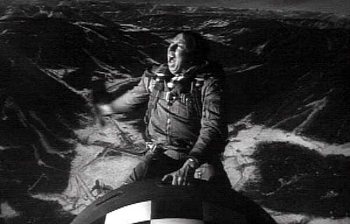
"I first became aware of it, Mandrake, during the physical act of love. Yes, a profound sense of fatigue, a feeling of emptiness followed. Luckily I was able to interpret these feelings correctly. Loss of essence. I can assure you it has not recurred, Mandrake. Women sense my power and they seek the life essence. I do not avoid women, Mandrake. But I do deny them my essence."
"Well, boys, we got three engines out, we got more holes in us than a horse trader's mule, the radio is gone and we're leaking fuel and if we was flying any lower why we'd need sleigh bells on this thing. But we got one little budge on those Rooskies. At this height, why, they might harpoon us but they dang sure ain't gonna spot us on no radar screen!"
"I think you're some kind of deviated prevert. I think General Ripper found out about your preversion, and that you were organizing some kind of mutiny of preverts."
"If the pilot's good, I mean if he's reeeally sharp, he can barrel that thing in so low, oh it's a sight to see. You wouldn't expect it with a big ol' plane like a '52, but varrooom! The jet exhaust frying chickens in the barnyard!"
"Mein Fuhrer! I can valk!"
"Aaaaaa hoooo! Waaaaa haaaawwwww!!!!"
Book-length treatises have been written about this pioneering director's work, with special attention given to the art and craft he demonstrated here. I won't presume to improve on what's been said before. Suffice it to say that here is one of our finest directors at the top of his form. You can find a remarkable archive of documentary materials on Kubrick and his work at The Kubrick Site.
|
2.
It's the 40th Anniversary Two-Disc Special Edition DVD
|
This is the third time Dr. Strangelove has been released on DVD. Columbia TriStar's 2001 Special Edition was the first to include generous bonus extras we've come to expect from this format, particularly with releases of seminal classics. This 2004 40th Anniversary release carries over those extras, then adds more for good measure. And we get the best-yet print and transfer, plus two new home-theater audio options.
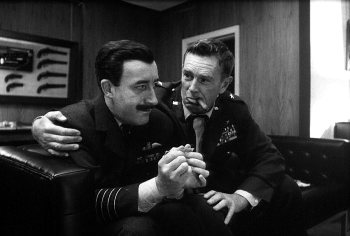 This edition gives us a high-definition transfer struck for the first time from a fine-grain source master, rather than from a print. Although the image has not been digitally polished, the source was obviously in excellent condition. The high-contrast black-and-white image is clean and glossy. The transfer is invisible, with no digital artifacts. While the 2001 edition also provided a high-quality image, in a side-by-side comparison this one bests it a little by appearing slightly sharper and definitely darker. This improves on the sometimes over-bright 2001 edition while bringing home the rich tones and shades of the blacks and whites and all those grays in between.
This edition gives us a high-definition transfer struck for the first time from a fine-grain source master, rather than from a print. Although the image has not been digitally polished, the source was obviously in excellent condition. The high-contrast black-and-white image is clean and glossy. The transfer is invisible, with no digital artifacts. While the 2001 edition also provided a high-quality image, in a side-by-side comparison this one bests it a little by appearing slightly sharper and definitely darker. This improves on the sometimes over-bright 2001 edition while bringing home the rich tones and shades of the blacks and whites and all those grays in between.
This edition also freezes the film's formerly troublesome aspect ratio with an anamorphic transfer set uniformly to 1.66:1. In previous editions multiple aspect ratios varied scene by scene between 1:37 full-frame and an artificially matted (and inoffensively awkward) pseudo-letterboxed widescreen. Kubrick's own preference on the issue, if any, is at best a murky point. The variable format of the 2001 edition (as well as the earlier Criterion Laserdisc) was touted as "authorized" by Kubrick, though the changing ratios never really amounted to much and were, let's face it, rather pointless. Moreover, it's plain that this new edition's uniform format, which recreates how U.S. theatrical audiences originally viewed the film, frames Kubrick's meticulous compositions very well and removes the distracting blurred matting edges that previously drew attention away from the film itself. Purists determined to possess the (debatable) "director's original intent" will want to keep the 2001 edition on hand for its floating aspect ratios. This 40th Anniversary edition, though, is on the whole the visually superior and definitive release.
The audio setup menu audio again preserves the original Dolby 1.0 monaural soundtrack, and it's perfectly fine. New here are two clean, strong, and well-balanced 5.1 options — one Dolby Digital, the other DTS — produced from the original sound elements. These two 5.1 choices are all but indistinguishable from one another. Both respect the original front-centric audio and avoid gratuitous surround effects, limiting the rear-speaker support to subtle background wallpaper, such as the faint sustained engine roar of Major Kong's B-52 or the echo-chamber ambience of the cavernous War Room. The .1 low-end channel kicks in only rarely.
If you prefer, you can enjoy the film's satirical verbal playground and cracker-crisp dialogue in French, or with subtitles in English, French, Chinese, Korean, and Thai.
Extras
Disc Two holds this collection of new and archival supplementary material:
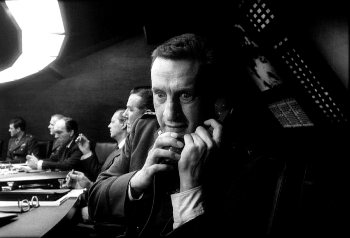 No Fighting in the War Room, or: Dr. Strangelove and the Nuclear Threat (30 mins.) — New for this edition is this insightful documentary that contextualizes Dr. Strangelove within the Cold War that gave it a reason to be. On hand are Roger Ebert, Washington Post assistant managing editor Bob Woodward, directors Joe McGrath and Spike Lee, editor Anthony Harvey, James Earl Jones, Sellers/Kubrick biographer Alexander Walker, and — for the authentic insider perspective — former Secretary of Defense Robert McNamara (The Fog of War). Together they connect the big red dots between the film and the Cold War's real-life dynamics of Mutually Assured Destruction. (And, for extra relevance, between wartime groupthink and today's more reality-based geopolitical heat sources.) Dr. Strangelove is revealed to be not only a cinema masterpiece or a product of archeo-history that predates the births of many of this DVD's viewers. Instead we also see it as a purposeful reflection of political-military thinking that is anything except obsolete. Here's a documentary that by itself makes this DVD worthy of an upgrade purchase, and it elevates this edition beyond just another old classic on the shelf.
No Fighting in the War Room, or: Dr. Strangelove and the Nuclear Threat (30 mins.) — New for this edition is this insightful documentary that contextualizes Dr. Strangelove within the Cold War that gave it a reason to be. On hand are Roger Ebert, Washington Post assistant managing editor Bob Woodward, directors Joe McGrath and Spike Lee, editor Anthony Harvey, James Earl Jones, Sellers/Kubrick biographer Alexander Walker, and — for the authentic insider perspective — former Secretary of Defense Robert McNamara (The Fog of War). Together they connect the big red dots between the film and the Cold War's real-life dynamics of Mutually Assured Destruction. (And, for extra relevance, between wartime groupthink and today's more reality-based geopolitical heat sources.) Dr. Strangelove is revealed to be not only a cinema masterpiece or a product of archeo-history that predates the births of many of this DVD's viewers. Instead we also see it as a purposeful reflection of political-military thinking that is anything except obsolete. Here's a documentary that by itself makes this DVD worthy of an upgrade purchase, and it elevates this edition beyond just another old classic on the shelf.
Inside the Making of Dr. Strangelove (46 mins.) — Hardcore Kubrick fan and filmmaker David Naylor was selected to produce this item, which (thank heavens) is a genuine "documentary" rather than another typical "making-of" marketing puff-piece. It takes us into the complete life cycle of Dr. Strangelove's production, from script development, casting, design, promotion, and the enormous difficulties as well as the serendipitous discoveries that ultimately came together into the finished production. Though the film has outlived most of its creators, Naylor found several people who worked on it, including cinematographer Gil Taylor and production designer Ken Adam (of the James Bond series). He also secured material from actors Shane Rimmer and James Earl Jones. The piece is jazzily written and produced, sporting a respectful scholarly demeanor. It shows us stills from the never-seen Great Pie Fight climax and explains why the scene was replaced with the radically different (and superior) existing finale. (This item appeared previously on the 2001 Columbia TriStar edition.)
The Art of Stanley Kubrick: From Short Films to Strangelove (14 mins.) — There's not much depth in this brief biographical overview, though it's a well-made introduction for viewers new to the director's early life and work. (This item appeared previously on the 2001 Columbia TriStar edition.)
Best Sellers: Peter Sellers Remembered (18 mins.) — Sellers' "breathtaking versatility" is appropriately lauded by Michael Palin, Roger Ebert, Shirley MacLaine, Richard Lester, David Frost, Bob Woodward, Spike Lee, and others. Sketching out his life from his boyhood to his early success on BBC Radio's pathbreaking The Goon Show, then to the international stardom that crystallized in Dr. Strangelove and Being There, this biography/eulogy underlines not only Sellers' talent, but also the "enigma" of the man who seemed to possess no singular identity except when playing a character.
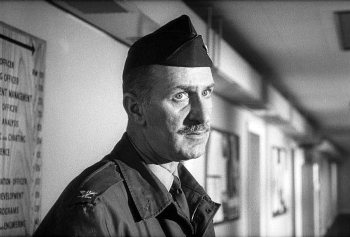 An Interview with Robert McNamara (24 mins.) — This interview is exactly that: a simple one-camera sit-down with McNamara that isn't gummed up with production lacquer. It's unedited — they left in someone bumping the camera, and near the end the former Secretary of Defense lets the director know who's boss by telling him no, he has this much time left — so it's a refreshing raw discussion. McNamara dishes the goods on what went on behind the scenes during the Kennedy and Johnson years, when the so-called Cold War was hotter than the rest of us knew. He is passionate and well-spoken on the long-lasting impact of the Cuban Missile Crisis and the inherent irrationality, depicted in Dr. Strangelove, of a deterrence-based defense philosophy that ignores the X factors of human fallibility. "We've got to get rid of nuclear weapons," he says, and he should know. Parallels between the film and global tensions c. 2004 are not ignored. (Clips from this interview appear in No Fighting in the War Room.)
An Interview with Robert McNamara (24 mins.) — This interview is exactly that: a simple one-camera sit-down with McNamara that isn't gummed up with production lacquer. It's unedited — they left in someone bumping the camera, and near the end the former Secretary of Defense lets the director know who's boss by telling him no, he has this much time left — so it's a refreshing raw discussion. McNamara dishes the goods on what went on behind the scenes during the Kennedy and Johnson years, when the so-called Cold War was hotter than the rest of us knew. He is passionate and well-spoken on the long-lasting impact of the Cuban Missile Crisis and the inherent irrationality, depicted in Dr. Strangelove, of a deterrence-based defense philosophy that ignores the X factors of human fallibility. "We've got to get rid of nuclear weapons," he says, and he should know. Parallels between the film and global tensions c. 2004 are not ignored. (Clips from this interview appear in No Fighting in the War Room.)
Two promotional split-screen interviews with Peter Sellers and George C. Scott (7 mins.) — For this promotional curio, Sellers and Scott were filmed individually answering scripted questions over telephones. Their footage was placed into the right-hand half of the film, the left half remaining black. TV news organizations could then film their reporters on telephones asking the questions, place their footage alongside Sellers' and Scott's pre-filmed responses, and create the illusion that a one-on-one interview was occurring. Both bifurcated interviews are gems. A highlight of the Sellers piece is his giving us a vocal dialect map of England, sliding effortlessly from London Cockney to Yorkshire brogue and elsewhere. (This item appeared previously on the 2001 Columbia TriStar edition.)
Previews round up trailers for Dr. Strangelove (a little milestone of a marketing piece in itself), The Bridge on the River Kwai, Fahrenheit 9/11, The China Syndrome, From Here to Eternity, and On the Waterfront.
The Filmographies are your standard résumé text frames for Kubrick, Sellers, Scott, Hayden, Keenan Wynn, Pickens, and James Earl Jones.
An Original Advertising Gallery is a short click-through collection of poster and advertising art.
Housed separately within the overwrapping sleeve is a "collectible scrapbook" with several pages of glossy production stills and an affectionate tribute to the film by Roger Ebert, who needed a copyeditor but otherwise hits his nails on the head.
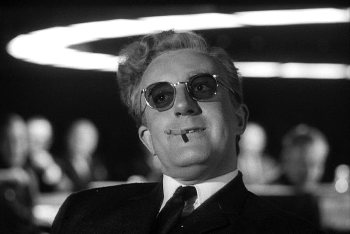 This is still cinema's most dead-on satire. It's a darkly farcical time capsule preserving the justified fear and often lunatic paranoia of the Cold War. Even without that context, it remains a superb screen achievement, period. Dr. Strangelove's brilliance comes from its script, its director, and its astonishing number of fine performances, a confluence of talent the likes of which happens far too rarely. It's one of those rare screen experiences that still balances out all the crap slapped onto screens (and pressed onto DVDs) year after year.
This is still cinema's most dead-on satire. It's a darkly farcical time capsule preserving the justified fear and often lunatic paranoia of the Cold War. Even without that context, it remains a superb screen achievement, period. Dr. Strangelove's brilliance comes from its script, its director, and its astonishing number of fine performances, a confluence of talent the likes of which happens far too rarely. It's one of those rare screen experiences that still balances out all the crap slapped onto screens (and pressed onto DVDs) year after year.
The New York Film Critics named Kubrick Best Director for Dr. Strangelove, and the film earned four Academy Award nominations: Best Picture, Best Director, Best Actor (Sellers), and Best Screenplay Based On Material From Another Medium. The American Film Institute ranks it #26 on their list of the 100 Best American Movies and #3 of America's 100 Funniest Movies.
For the ideal bookend to Dr. Strangelove, find 1964's other atomic holocaust classic, Fail-Safe. They were released within months of one another, a fact that underlines the notion that for an entire generation of movie-goers nuclear annihilation was a possibility every bit as believable as today's possibility of, say, voting shenanigans in Florida.
Humanity has the means (and too often, it seems, the will) to stop our clock on this planet at any time. Yet we also create the Louvre, great cathedrals, Hamlet, caramel macchiato coffee, and Dr. Strangelove. If someone does finally push The Button and we go the way of the dinosaurs, at least Kubrick's originally-envisioned extraterrestrial paleontologists will have this to show that we went out wearing the red bozo nose (and that we, by God, had Peter Sellers).
—Mark Bourne




- 1.66:1 anamorphic widescreen
- Two single-sided, dual-layered discs (SS-DL)
- DD 1.0 English, DD 5.1 English, DTS 5.1 English, DD 1.0 French
- Subtitles: English, French, Chinese, Korean, Thai
- No Fighting in the War Room, or: Dr. Strangelove and the Nuclear Threat
- Inside the Making of Dr. Strangelove
- The Art of Stanley Kubrick: From Short Films to Strangelove
- Best Sellers: Peter Sellers Remembered
- An Interview with Robert McNamara
- Two promotional split-screen interviews with Peter Sellers and George C. Scott
- Previews
- Filmographies
- Original Advertising Gallery
- Collectible scrapbook
- Two-disc keep-case with paperboard sleeve
![[box cover]](../../reviewimgs/d/drstrangelove_40ae.jpg)
 To audiences old enough in 1964 to be cognizant of the world around them, whose awareness of a Russian nuclear arsenal pointed at the U.S., of U.S. nuclear missiles pointed at Russia from silos across the midwest, of "duck and cover" drills in public schools, of homemade bomb shelters and maps of radiation fallout zones — whose day-to-day fatalism regarding an oncoming apocalypse was as ordinary as today's frets about stock market trends — Dr. Strangelove was a shocking pie in the face. Its comedic skew on deadly serious topics and caricatures of military planners and blinkered politicos seemed more incisive than its humorless contemporaries such as Fail-Safe and On the Beach. When it premiered, JFK was only two months dead, and the fear of imminent destruction surrounding the Cuban Missile Crisis was still a recent memory. Add anxiety about out-of-control technologies, of people serving machines rather the other way around, and the time was exactly right for an antiestablishment film that picked the scab off our national neuroses. This most mordant of black comedies made us laugh grimly though clenched teeth.
To audiences old enough in 1964 to be cognizant of the world around them, whose awareness of a Russian nuclear arsenal pointed at the U.S., of U.S. nuclear missiles pointed at Russia from silos across the midwest, of "duck and cover" drills in public schools, of homemade bomb shelters and maps of radiation fallout zones — whose day-to-day fatalism regarding an oncoming apocalypse was as ordinary as today's frets about stock market trends — Dr. Strangelove was a shocking pie in the face. Its comedic skew on deadly serious topics and caricatures of military planners and blinkered politicos seemed more incisive than its humorless contemporaries such as Fail-Safe and On the Beach. When it premiered, JFK was only two months dead, and the fear of imminent destruction surrounding the Cuban Missile Crisis was still a recent memory. Add anxiety about out-of-control technologies, of people serving machines rather the other way around, and the time was exactly right for an antiestablishment film that picked the scab off our national neuroses. This most mordant of black comedies made us laugh grimly though clenched teeth.
 Beyond the characters Mandrake, President Merkin Muffley, and Dr. Strangelove, Sellers was also originally slated to play Major Kong. But mastering a Texas accent proved difficult, and while shooting the famous bomb scene 15 feet above the stage floor, Sellers fell and broke his leg. Knowing that no ordinary actor could replace Sellers, Kubrick cast Slim Pickens, whom he had worked with briefly in a previous movie, because Pickens was by nature already a cowboy-hat-wearing, prairie-swaggering, good-ol'-boy personality.
Beyond the characters Mandrake, President Merkin Muffley, and Dr. Strangelove, Sellers was also originally slated to play Major Kong. But mastering a Texas accent proved difficult, and while shooting the famous bomb scene 15 feet above the stage floor, Sellers fell and broke his leg. Knowing that no ordinary actor could replace Sellers, Kubrick cast Slim Pickens, whom he had worked with briefly in a previous movie, because Pickens was by nature already a cowboy-hat-wearing, prairie-swaggering, good-ol'-boy personality.
 Who would have thought that an actor who
Who would have thought that an actor who Any one of his performances here — Group Captain Mandrake, President Muffley, and Dr. Strangelove himself — would have distinguished Sellers mightily. Put them together and you have a screen record of one of the rare instances when the phrase "utter brilliance" isn't overreaching hyperbole. Yes, Rex Harrison was good in My Fair Lady, but here's the real Best Performance By An Actor for 1964. Intuitively gifted at characterization and improvisation, Sellers could riff on dialogue the way a great jazz musician creates amazing music. He regularly cracked up the Dr. Strangelove cast during shooting. We are a poorer species without him.
Any one of his performances here — Group Captain Mandrake, President Muffley, and Dr. Strangelove himself — would have distinguished Sellers mightily. Put them together and you have a screen record of one of the rare instances when the phrase "utter brilliance" isn't overreaching hyperbole. Yes, Rex Harrison was good in My Fair Lady, but here's the real Best Performance By An Actor for 1964. Intuitively gifted at characterization and improvisation, Sellers could riff on dialogue the way a great jazz musician creates amazing music. He regularly cracked up the Dr. Strangelove cast during shooting. We are a poorer species without him.
 This edition gives us a high-definition transfer struck for the first time from a fine-grain source master, rather than from a print. Although the image has not been digitally polished, the source was obviously in excellent condition. The high-contrast black-and-white image is clean and glossy. The transfer is invisible, with no digital artifacts. While the 2001 edition also provided a high-quality image, in a side-by-side comparison this one bests it a little by appearing slightly sharper and definitely darker. This improves on the sometimes over-bright 2001 edition while bringing home the rich tones and shades of the blacks and whites and all those grays in between.
This edition gives us a high-definition transfer struck for the first time from a fine-grain source master, rather than from a print. Although the image has not been digitally polished, the source was obviously in excellent condition. The high-contrast black-and-white image is clean and glossy. The transfer is invisible, with no digital artifacts. While the 2001 edition also provided a high-quality image, in a side-by-side comparison this one bests it a little by appearing slightly sharper and definitely darker. This improves on the sometimes over-bright 2001 edition while bringing home the rich tones and shades of the blacks and whites and all those grays in between.
 No Fighting in the War Room, or: Dr. Strangelove and the Nuclear Threat (30 mins.) — New for this edition is this insightful documentary that contextualizes Dr. Strangelove within the Cold War that gave it a reason to be. On hand are Roger Ebert, Washington Post assistant managing editor Bob Woodward, directors Joe McGrath and Spike Lee, editor Anthony Harvey, James Earl Jones, Sellers/Kubrick biographer Alexander Walker, and — for the authentic insider perspective — former Secretary of Defense Robert McNamara (
No Fighting in the War Room, or: Dr. Strangelove and the Nuclear Threat (30 mins.) — New for this edition is this insightful documentary that contextualizes Dr. Strangelove within the Cold War that gave it a reason to be. On hand are Roger Ebert, Washington Post assistant managing editor Bob Woodward, directors Joe McGrath and Spike Lee, editor Anthony Harvey, James Earl Jones, Sellers/Kubrick biographer Alexander Walker, and — for the authentic insider perspective — former Secretary of Defense Robert McNamara ( An Interview with Robert McNamara (24 mins.) — This interview is exactly that: a simple one-camera sit-down with McNamara that isn't gummed up with production lacquer. It's unedited — they left in someone bumping the camera, and near the end the former Secretary of Defense lets the director know who's boss by telling him no, he has this much time left — so it's a refreshing raw discussion. McNamara dishes the goods on what went on behind the scenes during the Kennedy and Johnson years, when the so-called Cold War was hotter than the rest of us knew. He is passionate and well-spoken on the long-lasting impact of the Cuban Missile Crisis and the inherent irrationality, depicted in Dr. Strangelove, of a deterrence-based defense philosophy that ignores the X factors of human fallibility. "We've got to get rid of nuclear weapons," he says, and he should know. Parallels between the film and global tensions c. 2004 are not ignored. (Clips from this interview appear in No Fighting in the War Room.)
An Interview with Robert McNamara (24 mins.) — This interview is exactly that: a simple one-camera sit-down with McNamara that isn't gummed up with production lacquer. It's unedited — they left in someone bumping the camera, and near the end the former Secretary of Defense lets the director know who's boss by telling him no, he has this much time left — so it's a refreshing raw discussion. McNamara dishes the goods on what went on behind the scenes during the Kennedy and Johnson years, when the so-called Cold War was hotter than the rest of us knew. He is passionate and well-spoken on the long-lasting impact of the Cuban Missile Crisis and the inherent irrationality, depicted in Dr. Strangelove, of a deterrence-based defense philosophy that ignores the X factors of human fallibility. "We've got to get rid of nuclear weapons," he says, and he should know. Parallels between the film and global tensions c. 2004 are not ignored. (Clips from this interview appear in No Fighting in the War Room.)
 This is still cinema's most dead-on satire. It's a darkly farcical time capsule preserving the justified fear and often lunatic paranoia of the Cold War. Even without that context, it remains a superb screen achievement, period. Dr. Strangelove's brilliance comes from its script, its director, and its astonishing number of fine performances, a confluence of talent the likes of which happens far too rarely. It's one of those rare screen experiences that still balances out all the crap slapped onto screens (and pressed onto DVDs) year after year.
This is still cinema's most dead-on satire. It's a darkly farcical time capsule preserving the justified fear and often lunatic paranoia of the Cold War. Even without that context, it remains a superb screen achievement, period. Dr. Strangelove's brilliance comes from its script, its director, and its astonishing number of fine performances, a confluence of talent the likes of which happens far too rarely. It's one of those rare screen experiences that still balances out all the crap slapped onto screens (and pressed onto DVDs) year after year.
